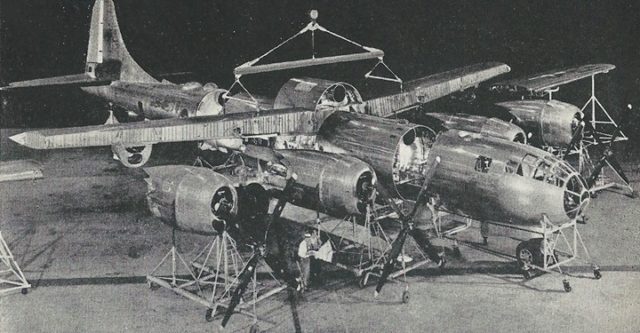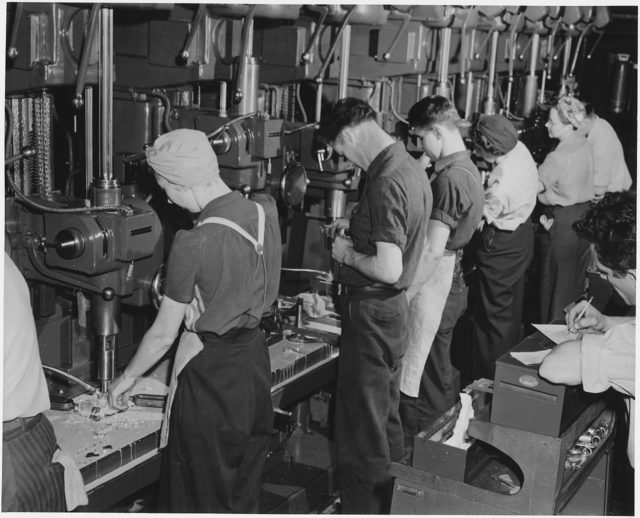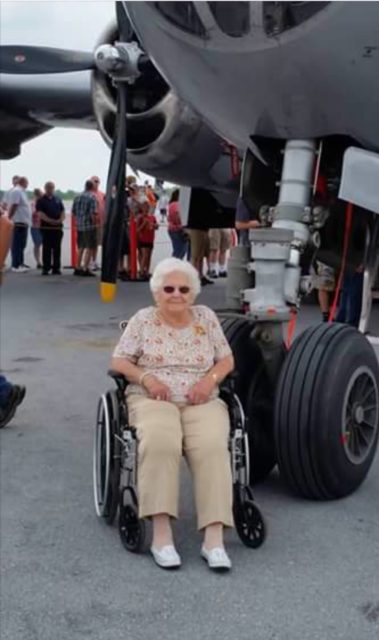Building a B-29 Piece by Piece
I’m in Austria this week, giving a presentation about the representation of old women in science fiction. So it seemed only right to celebrate a woman in aviation who might not otherwise have received the recognition that she deserved.
I’d like to introduce you to Matt’s grandmother, Edna!
Edna lived in Detroit in 1945, the same city where William Boeing was born in 1885. So perhaps it is no coincidence that, in 1945, she ended up working on Boeing aircraft, specifically the assembly of the Boeing B-29 Superfortress.
The B-29 was the US’s first long-range, heavy bomber and the single most expensive weapons project during World War 2. It entered combat service in 1944 and could travel almost 5,500 miles while carrying six tons of bombs. The B-29 innovations included a pressurized cabin, tricycle landing gear and a computer-controlled firing system which allowed a single gunner and fire-control officer to operate four machine gun turrets. The aircraft were also heavily used in the Korean War but were discontinued in 1960.
Boeing had four main-assembly factories but they were unable to keep up with demand. Initially Chrysler Corporation was given the job of producing 1,000 Cyclone powerplants per month, the amount needed to keep up with the production of the four-engined bombers.

The US ended up relying heavily on the automobile industry to supply airframe components and engines at the speed required, which is where Detroit comes in. Chrysler workers in Detroit built the B-29 engine cowling sets and the front fuselage sections, installing 50,000 rivets, four miles of wiring and 8,000 different parts in the nose section at Chrysler’s DeSoto Division. Meanwhile, the rear fuselage sections behind the wings (including the tail gunner’s location) were also built in Detroit, by the Hudson Motor Car Company. Briggs Manufacturing had 31,000 employees in their Detroit plants, producing aft and forward bomb doors, nose wheel doors and outer wings. The Fisher Body Division of General Motors made the most complex component of the B-29, the engine nacelles, which consisted of 1,300 sub-assemblies. Although the parts were produced in Cleveland, they were assembled in Detroit.

It’s not clear where Edna worked but it could have been any of the above or possibly, having talked about assembling bombers, she was based at Willow Run, also known as Air Force Plant 31, which is not too far out of Detroit. The plant was set up by Ford Motor Company to built components but in 1941 Boeing gave them permission to assemble bomber planes.
This year, Edna turned 94 and it turned out she’d never actually seen one of the finished aircraft that she had helped to assemble. Seventy-three years after her job assembling B-29 components, she got the opportunity to get close up and personal with a completed operational B-29 Superfortress.

Matt gave me permission to share this photograph with you, which is Edna sitting next to Fifi, one of just two B-29s that are still operational. Sadly, they don’t appear to have volunteered to take her up in it for a flight… it seems to me that would be the least they could do!
References:
- Matt (Edna’s proud grandson)
- The B-29 and the US Auto Industry in World War Two
- The B-29 Superfortress: Dodge plays a major role








My dad flew in a B-29. Glad that Edna got to see one.
I want to know more about the presentation of old women in SF!
Hmm, I’ll see about making something public on the subject!
It’s been published in the SFRA Review… http://www.sfra.org/resources/Documents/SFRA Review 327.pdf
Oh, thank you! I did not know that was out.
It’s a pity they couldn’t take her up, but I’d be surprised if there was a way to get her in safely; IIRC the B-29 wasn’t as tight as I’ve heard the Do-17 was (where the crew had to board in a specific order), but I wonder whether they could get somebody with mobility issues into the plane.
I also want to know about your presentation; I had no idea that was an interest of yours. (Putting on conventions has been my primary hobby for several decades.) I assume Moon’s _Remnant Population_ is in your list somewhere — it caused quite a stir (in several directions) for (among other things) not portraying an old woman as out of it.
Good point about getting her in, I hadn’t thought about it. And yes! The list is only 31 books long but Remnant Population most certainly is on it!
Y dad worked on the B-29 landing gear development in Cleveland in late 30s to early 40d. He was a tool and die maker and recruited from his hometown of Salem Ohio to work in Cleveland. Does anyone know the name of the plant in Cleveland? My dad passed away in 1990 so I cannot ask him
Source: https://case.edu/ech/articles/f/fisher-body-division-general-motors-corp